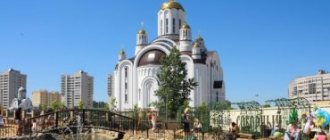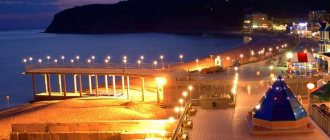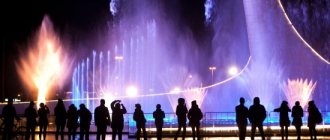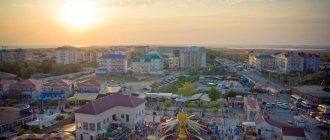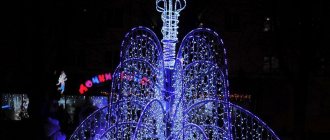What to see in Smolensk in 1 day: TOP-5
The city amazes with its variety of historical monuments and cultural and educational institutions. The cultural tourism program should begin with a visit to the main attractions of Smolensk.
Smolensk Kremlin
- Address: It is better to start exploring the fortress from the street. Student. Transport stop "Ulitsa Studencheskaya".
The extremely advantageous strategic location of Smolensk made it, in fact, the key to capturing Moscow. This was understood not only by numerous conquerors - from Napoleon to Hitler, but also by the Russian tsars. Back in the time of Ivan the Terrible, a decision was made to build an impregnable citadel on the site of a wooden fortress that had regularly defended the city for hundreds of years.
By 1605, the construction of a fortification with powerful stone walls more than 5 m thick and about 19 m high, topped with traditional Russian battlements in the shape of a forked swallowtail, was completed.
The fortress had 37 round, square and hexagonal towers, 9 of which had passages with strong gates. Part of the fortress wall and 17 towers have been perfectly preserved to this day. An image of the Smolensk Kremlin can be found on a silver commemorative coin issued by the Bank of Russia in 1995.
Monument to the heroes of the war of 1812
- Address: st. Kommunisticheskaya, 6A. Transport stop "Victory Square".
In the Patriotic War, Smolensk was destined to play an outstanding role. It was near the walls of the fortress on August 16-18, 1812 that one of the most important battles of the company took place, which significantly influenced its outcome. The two-day battle of the Russian army under the command of Barclay de Tolly and Bagration with Napoleon's superior troops did not bring an advantage to either side. The battle was distinguished by particular tenacity and bloodshed.
French losses are estimated at 14 thousand, and Russian losses at 12 thousand. On the 100th anniversary of the battle, a monument appeared in Smolensk in memory of its heroes, the opening of which was attended by Emperor Nicholas III. Two eagles with outstretched wings protect a nest on the top of a rock from a Gallic warrior in armor climbing it. On the sides of the 10-meter-high monument there are bronze coats of arms of Smolensk, Russia and a memorial plaque “Grateful Russia to the Heroes of 1812.”
Memorial "Mound of Immortality"
- Address: Readovsky Park. Transport stop "Chernyakhovskogo Street".
During the Great Patriotic War, Smolensk was again destined for the role of the main defender of Moscow. The heroic defense of the city for two months, from July 10 to September 10, 1941, did not allow Hitler and his generals to implement the Barbarossa plan. A terrible price had to be paid for this. More than 700 thousand Soviet soldiers gave their lives so that the offensive of Army Group Center was suspended, which made it possible to gather forces for the defense of Moscow.
To celebrate the 27th anniversary of the liberation of Smolensk from the Nazis, a memorial was opened in the city in memory of its defenders. A stele rises above the Kurgan, which has the shape of a truncated pyramid. On the pages of an 11-meter-long open book, the dates of the beginning and end of the terrible war are stamped out of concrete, below which are carved bas-reliefs of a worker, a partisan, a warrior and a mother with a child.
Nikolsky Gate
- Address: st. Marshala Zhukova, 6. Transport stop “Isakovsky Street”.
The gate and the powerful tower guarding it, erected during the time of Ivan the Terrible, received their current name at the beginning of the 18th century. from a temple built nearby. They say that it was from here that Napoleon entered the city after the Russian army retreated from Smolensk in 1812. But this is not the only thing that makes the gate a special attraction.
One very interesting fact is connected with them, which scientists cannot explain. At one time, an icon was placed in a special niche above the gate. In a photograph of the image taken in 1911, the white silhouette of a small chapel is clearly visible on the fortress wall. Historians claim that the tower never had such an extension.
House of A.P. Engelhardt
- Address: st. Glinka, 4. Transport stop “Kommunisticheskaya Street”.
Among the architectural monuments of Smolensk, the magnificent mansion erected in 1878 for A.P. is especially popular and loved by the townspeople. Engelhardt. The house is an excellent example of eclectic architecture, relevant for Russia in the 19th century.
The Baroque facade with many windows is richly decorated with stucco elements, columns with luxurious pilasters, flowerpots and attics. But its value for Smolensk lies not only in this. The expression “Go to Edik” means that someone is going to get married, because now this elegant building houses the Wedding Palace.
The main attraction is the Holy Assumption Cathedral
The Assumption Cathedral of Smolensk stands on a high hill and is visible from almost anywhere in the city.
And I’ll start my story-guide to the sights of Smolensk with the Assumption Cathedral - a pearl of architecture, the main symbol of the city.
The temple rises above the city and no matter from which side you enter the city, you will see a white and turquoise temple hovering over Smolensk. An unforgettable sight!
The first Assumption Cathedral in Smolensk was founded in 1101 by Prince Vladimir Monomakh, who for some time was the Prince of Smolensk (1073-1078), and then the Prince of Chernigov, Pereyaslavl and, finally, Kyiv. It was a large city cathedral, the first stone church in Smolensk, consecrated in 1150.
In September 1609, the Polish army led by King Sigismund III besieged Smolensk. After a long 20 months of siege, the enemy broke into the city on June 3, 1611.
The defenders of the city hid in the Assumption Cathedral. A terrible explosion, the origin of which is still unclear, destroyed the entire top of the cathedral. The townspeople were buried under piles of stones. The surviving people were finished off by the Poles.
However, the Polish invaders did not destroy the cathedral. They covered it with planks and built a church in it.
At that time, a huge part of the Russian land was captured by Poland and the Grand Duchy of Lithuania, which united and created the state of the Polish-Lithuanian Commonwealth.
And only under the reign of Tsar Alexei Mikhailovich in the fall of 1653, as a result of repeated assaults, was it possible to return the city to the Russian state through negotiations with the Polish side.
The ceremonial laying of the new Assumption Cathedral in Smolensk took place on August 2, 1677.
History of the Assumption Cathedral
The Assumption Cathedral took 100 years to build - from 1677 to 1772.
The fact that the cathedral was built by three architects is evidenced by its architecture. In 1772, the construction of the Assumption Cathedral was completed. Since that time, no special changes have been made to the appearance of the cathedral; only in 1890 a glass porch was added to the western façade.
The style of the Smolensk Assumption Cathedral is Ukrainian Baroque.
The height of the Assumption Cathedral is about 70 meters. This is one of the most grandiose and beautiful cathedrals. It can accommodate up to 5,000 people.
Majestic, solemn and long-suffering, he experienced a lot while on the western borders of the Russian state. But even the enemies understood that such a work of architecture could not be destroyed.
The cathedral survived the fire of 1812.
The cathedral survived the Great Patriotic War. It served as a landmark during the bombing of the city by the Germans, but it itself remained intact.
The cathedral could have been destroyed by our troops. During the defense of the city, the commander of the 16th Army, General Mikhail Fedorovich Lukin, received an order to blow up the cathedral, which was a powerful landmark for aiming artillery guns. But Lukin did not carry out the order.
The fate of this landmark not only for Smolensk, but also for all of Russia, Orthodox cathedral with a unique wooden gilded carved iconostasis of about 30 meters was fortunate. The iconostasis was made by Ukrainian craftsmen and this explains the large number of sculptures on it - angels, oak and maple leaves, sunflowers, grapes...
The royal doors of the altar, the largest in Europe, are also unique - they are crowned with a nest with a bird, and not with a cup or dove (the Holy Spirit), as is traditionally the case.
Shrines of the Assumption Cathedral
The main attraction of the Smolensk Cathedral is the holy miraculous icon of the Mother of God Hodegetria, reverently revered not only by the Smolensk province, but also by all of Orthodox Russia. It was written, according to Nicephorus Callistus, by the evangelist Luke at the request of the ruler of Syria, Theophilus; therefore it is also called first-written.
Unfortunately, the prototype of the Smolensk icon, brought to the first Assumption Cathedral of Smolensk by Vladimir Monomakh, disappeared during the years of fascist occupation.
Another significant shrine of the cathedral is the shroud “The Burial of the Lord Jesus Christ” (1561) - a masterpiece of ancient Russian facial embroidery.
The Holy Assumption Cathedral operates at the address: st. Sobornaya Gora, 5. Entrance is open from: Mon-Sat 09:00-20:00; Sun 07:00-20:30.
Architectural delights of the city of Smolensk
Excursions around this wonderful city will bring a lot of impressions to an inquisitive tourist who knows how to appreciate beauty. Here are just a few attractions that are definitely worth seeing.
Temple of the Immaculate Conception
- Address: st. Uritsky, 10. Transport stop “Victory Square”.
The temple, built in the 19th century, is considered the best preserved architectural monument in the neo-Gothic style. Now its premises house the city archive, but before the revolution the church was the center of a fairly large Catholic parish.
Unfortunately, during the years of Soviet power, the stunning stained glass windows that decorated the tall lancet windows were lost, and the pipes of the ancient organ were melted down.
Restoration work in the temple has not yet been completed, but even now you can admire the pointed towers and the decoration of the facade of the beautiful building.
Veselukha Tower
- Address: Not far from the theological seminary building in the Industrial District. Transport stop "Green Stream".
One of the most massive towers included in the complex of the Smolensk fortress is “Veselukha”. The structure, erected on the top of a hill, literally hangs over the bend of the Dnieper riverbed, providing an excellent firing radius for archers and artillerymen. The tower received its name from a legend that came from ancient times.
Legend has it that builders faced with difficulties turned to a witch for help. She advised them to wall up the most beautiful maiden of Smolensk in the foundation of the tower, so that the wall would stand forever. The first beauty turned out to be the daughter of one of the merchants. At the same time, when they stoned her, the girl did not cry or ask for mercy, but laughed merrily.
Smolensky railway station
- Address: Vokzalnaya Square, 1. Transport stop "Vokzal".
At one time, the railway station building, erected at the end of the 19th century, was a true architectural decoration of Smolensk. However, it suffered a sad fate - complete destruction from bombing during the war. But literally 7 years after the end, the city found a station, not inferior in beauty to the destroyed one.
The building in the neo-Gothic style with a soft turquoise facade, lush columns, carved cornices and stucco decoration has since pleased the eyes of Smolensk residents and travelers from different cities of the country. In the halls of the station you can admire panoramic paintings by Neprintsev, Shishkin, Serov.
Blognier Garden
- Address: Not far from Lenin Square. Transport stop "Ulitsa Konenkova".
The whole family can have a wonderful time in the amazing park, founded back in 1830, on the site where the parade ground of the garrison troops took place. Walking along the shady alleys, you can enjoy neat flower beds to the sound of the crowns of centuries-old trees. The main highlight of the park is a small color and musical fountain.
Not far from it there is a monument to the great Russian composer Mikhail Glinka, who was born in the Smolensk province. Don’t forget to check out two bronze lions and a bronze sculpture of a Deer, cast at the beginning of the last century by master R. Friese especially for the country residence of Kaiser Wilhelm II.
Don't miss: Sights of the Smolensk region
Memorial “Katyn”
The Katyn Memorial is located 20 kilometers from the center of Smolensk, between the villages of Gnezdovo (which was mentioned above when talking about the founding of the city of Smolensk) and Katyn, on the site of the tragic events of the 1930–1940s, the victims of which were citizens of two countries - Soviet Union and Poland.
The memorial complex, opened in 2000, consists of two parts: the territory on which residents of the Smolensk region and nearby regions who were victims of political repression are buried, and a military cemetery where Polish prisoners of war are buried. The Polish part of the memorial was already fully equipped by this time, but the work to put in order the burials of our compatriots was never completed.
The creation of the Katyn Memorial began with the Decree of the Government of the Russian Federation “On the creation of memorial complexes in the burial places of Soviet and Polish citizens - victims of totalitarian repression in Katyn (Smolensk region) and Medny (Tver region)” dated October 19, 1996.
In 2021, on the territory of the Memorial, a new building of a museum and exhibition center was built and opened to the public, telling about the history of Russian-Polish relations in the 20th - early 21st centuries, and the improvement of the Russian part of the burial sites began.
Memorial part at the burial site of Soviet citizens.
In 2021, in the “Valley of Death” - part of the complex where the mass graves of Soviet citizens are located - a sculptural composition was opened, consisting of the “Execution” monument and the Wall of Memory, on which the names of the executed residents of the Smolensk region - victims of political repression - are engraved on slabs.
The peak of executions in the Goat Mountains (the name of the place near Katyn where the memorial is located) occurred in 1933–1939. Soviet people were brought here from Rzhev, Vyazma, Bryansk, Sukhinichi, Smolensk itself, as well as from the Baltic states, Ukraine and Belarus.
Behind the gates of the memorial complex, an alley begins leading to the First Ritual Site with a memorial plaque to 500 Soviet prisoners of war killed by the Nazis in May 1943. Nearby is a museum reconstruction of “GULAG on Wheels” - a freight car in which repressed citizens were transported to places of detention.
The monument to illegally repressed compatriots is a freight car for transporting people to places of imprisonment and execution.
The ten-meter Orthodox cross symbolizes eternal memory and repentance and opens the Russian part of the Memorial. Due to the fact that not all the remains were discovered and reburied, bridges were erected here to protect the peace of the dead people. Outside this Memorial, on the territory of the “Valley of Death”, there are more than 200 unfurnished graves of Soviet citizens, to whom a memorial sign was erected in 2009.
The tocsin of the Katyn bell calls for never forgetting the events of those times.
On the Polish part of the military cemetery, the remains of Polish officers are buried in 6 large mass graves, and the ashes of generals B. Bogatyrevich and M. Smorawiński are buried in individual graves. The altar group, consisting of an altar table and a Catholic cross, serves as an open-air temple. The Katyn Bell, placed below ground level, is intended to serve as a warning to future generations.
The Russian and Polish parts are united by the Memory Alley. This Alley calls for remembering what happened and learning lessons so that it never happens again.
On the territory of the Memorial there are exhibitions “The Polish-Soviet War of 1919-1921. The fate of the Red Army soldiers in Polish captivity" and "Ordered to be shot."
The memorial is worth visiting when you come to Smolensk. Perhaps this is the most significant memorable place in modern history not only of the Smolensk region.
The territory of the memorial complex is open for inspection every day from 9.00 to 21.00, entry for visitors is free.
You can get to the Memorial by public transport coming from Zhelyabov Square (buses to Katyn or Smetanino) or by taxi, which is inexpensive in Smolensk. The Yandex taxi service operates.
Monuments and monuments of Smolensk
Smolensk has a huge variety of different monuments and sculptural compositions, against the backdrop of which tourists take wonderful photographs as souvenirs.
Monument to Fyodor Kon
- Address: st. Dzerzhinsky, 12. Transport stop “October Revolution Street”.
In 1991, grateful Smolensk residents erected a monument to the great Russian architect not far from the Thunder Tower. It was thanks to the engineering and construction genius of Fyodor Savelyevich that the city acquired a powerful citadel, which remained impregnable for many years.
Thanks to the use of interesting design solutions, it was possible to make the walls very strong, almost resistant to cannonballs. Fedor designed each tower individually, based on the features of the terrain. Unfortunately, there are no portraits or other images of F. Horse, so the sculptor O. Komov created a kind of collective image of the architect.
Monument to the TU-16A aircraft
- Address: Bagration street.
Established in 1985. The event coincides with the awarding of the title “Hero City” to Smolensk. The monument is dedicated to the glorious defenders of the Motherland, natives of the Smolensk land.
The fact is that in 1940 the 212th separate bomber aviation regiment was stationed here. It became the core of future long-range aviation. Evgeniy Golovanov was appointed the first commander. He subsequently became the country's Air Chief Marshal.
The TU-16A aircraft was produced since 1953. It was discontinued only ten years later. Now he decorates one of the streets. There are red five-pointed stars on its tail.
Monument to Prince Vladimir
- Address: Dnieper embankment.
Installed in the summer of 2015 on the Dnieper coast - on the Vladimir embankment. Depicts Prince Vladimir - the great Baptist of Rus'.
The figure faces the river. The prince looks to be about thirty years old. All elements of clothing and shoes correspond to the historical era in which he lived. In one hand the Baptist holds a six-pointed patriarchal cross, and with the other he points to the Dnieper, which became the font of Russian Christianity.
The monument stands on a 5-meter pedestal. The height of the figure itself is 4 meters. This grandiose structure inspires awe and respect in everyone who sees it.
Monument to Tvardovsky
- Address: corner of Gagarin Ave. and st. Glinka.
Located in the city center, near the Smolensk hotel. Captured in company with his main character, Vasily Terkin. Front-line soldiers are depicted sitting opposite each other. They froze in a friendly conversation.
The monument was opened in 1995. This is the only monument in which the author and his literary hero are depicted together. The authorship belongs to the sculptor Sergeev. He did an incredible job! Bronze sculptures seem to be living people. Both idle tourists and indigenous residents love to take pictures against the backdrop of the monument.
Monument to Kutuzov
- Address: Square in Memory of Heroes.
Opened in 1954. The author of the attraction is the sculptor Motivilov. In his work, he was inspired by the image of the great commander from War and Peace.
The monument is made of bronze. The field marshal is captured in full height. His uncovered head is slightly raised, his gaze directed forward. The chest is decorated with medals. In the right hand is the hilt of the sword, in the left is the edge of the cloak. Facial features are clearly visible: a wide forehead, a hump nose, a double chin, a blind eye. The appearance is taken from the works of artists who painted Kutuzov from life. The appearance of the commander conveys determination and strong will. He is depicted at the very zenith of his glory.
The Motivilov monument is successfully combined with other monuments in honor of the defenders of Smolensk. Together they form an unforgettable architectural ensemble.
Heroes' Memorial Square
Near the fortress wall in the park in memory of heroes, the burial places of the fallen defenders of Smolensk.
Here, near the fortress wall, people are buried who gave their lives serving the people and the Fatherland. There are only two such memorials in Russia: the first is the well-known burial site on Red Square in Moscow, the second is in the hero city of Smolensk.
Burials of dead Soviet soldiers near the fortress wall began after the liberation of Smolensk and part of the region from the Nazi invaders. There are 39 graves along the fortress wall, including 4 memorial graves of Heroes of the Soviet Union:
- guard sergeant Oktyabrskaya Maria Vasilievna (08/16/1902 - 03/15/1944)
- partisan Kurylenko, Vladimir Timofeevich (12/25/24 - 05/14/1942)
- Colonel Gubenko, Anton Alekseevich (02/12/1908 - 03/31/1939)
- guard senior sergeant Mikhail Alekseevich Egorov (05/05/1923 - 06/20/1975)
Streets in Smolensk are named after them.
The Eternal Flame complex is located in the center of the square opposite the burial grounds. On September 28, 1968, during the celebration of the 25th anniversary of the liberation of the Smolensk region from the fascist invaders, the Eternal Flame was lit in the Memorial Park of Heroes. He was delivered by armored personnel carrier from Moscow from the Tomb of the Unknown Soldier.
The Park in Memory of Heroes acquired its modern appearance in 1975, when reconstruction was carried out and a granite stele was installed with the words of N. I. Rylenkov:
Comrade, remember: the faithful sons of Your Fatherland are buried here, That they did not spare their lives for it. They fulfilled their duty in full. Read and repeat their names And how they learn to serve the Fatherland.
On September 24, 2006, the Alley of Hero Cities was opened in the park. 13 concrete obelisks are installed in a row along the fortress wall. On each of them there is a Gold Star medal and the name of the hero city. Inside the obelisks are capsules with soil from the battle sites in the hero cities.
Why did I title my post “Sights in one day”? Because all these memorable places in Smolensk are located in the historical center of the city and within walking distance of each other. And I would begin my acquaintance with the Smolensk region in the morning from the international memorial “Katyn”, so that in the afternoon I could return to the city and finish sightseeing, which I described above.
Where to go with a child in Smolensk
Of course, in the city of Smolensk, certain attractions are ready for family visits, including those with children. However, it will also be interesting to see other places with your children.
Museum "In the World of Fairy Tales"
- Opening hours: daily from 10:00 to 18:00, Friday from 10:00 to 17:00.
- Ticket price: adult 50 rub., student 30 rub., children 20 rub., for preschoolers 10 rub.
- Telephone.
- Website: https://www.smolensk-museum.ru/catalog/v_mire_skazki
- Address: st. Lenina, 15. Transport stop “Tukhachevsky Street”.
Among the attractions of Smolensk for children, it is worth highlighting the wonderful museum “In the World of Fairy Tales,” founded in 1992. Any child will be delighted with an excursion to this wonderful place. Already at the entrance, young visitors will be greeted by Baba Yaga, Leshy, and Vasilisa the Beautiful.
They will invite children to answer questions in a short fairytale quiz and will accompany them until the end of the visit. The museum's exposition consists of reconstructions of scenes from Russian folk tales adored by children and the works of A.S. Pushkin. Everything is decorated amazingly colorfully with love for children.
Embankment of the Dnieper River
- Coordinates on the map: 54.791007, 32.043974.
Built for the 1150th anniversary of the city - in 2013. It runs along Bolshaya Krasnoflotskaya Street - from the bridge along the street. Belyaeva to the bridge on the street. Dzerzhinsky. Partially adjacent to the Pyatnitskaya Tower and the Smolensk Fortress. The embankment has three levels.
The upper one stretches for 865 km and covers an area of 13,000 square meters. m. From the shore there is a beautiful view of one of the districts of Smolensk. In 2015, a monument to Prince Vladimir was erected here. Since then, the embankment has been officially called Vladimirskaya.
Scientist's Bench
- Address: October Revolution Street.
It is located not far from the Smolensk Kremlin. Dedicated to the scientist and designer Nikolai Senev. The design consists of a wooden seat on a durable metal frame. Decorated with elements in the form of a grade book, images of an atom and other interesting details.
Talashkino
18 km south of Smolensk is the village of Talashkino, which has the status of a historical and artistic reserve. Previously, there was an estate of Princess Maria Tenisheva, who is famous for her charity. On the outskirts of the estate, the Flenovo farmstead was equipped with it, where peasant children learned to read and write. In general, the main goal of her life was the revival of peasant artistic craft. In this regard, numerous educational and artistic workshops appeared in the village, like mushrooms after rain. From 1893 to 1914, Talashkino was Abramtsev’s competitor in terms of artistic life; many sculptors, artists and other bohemians visited here.

